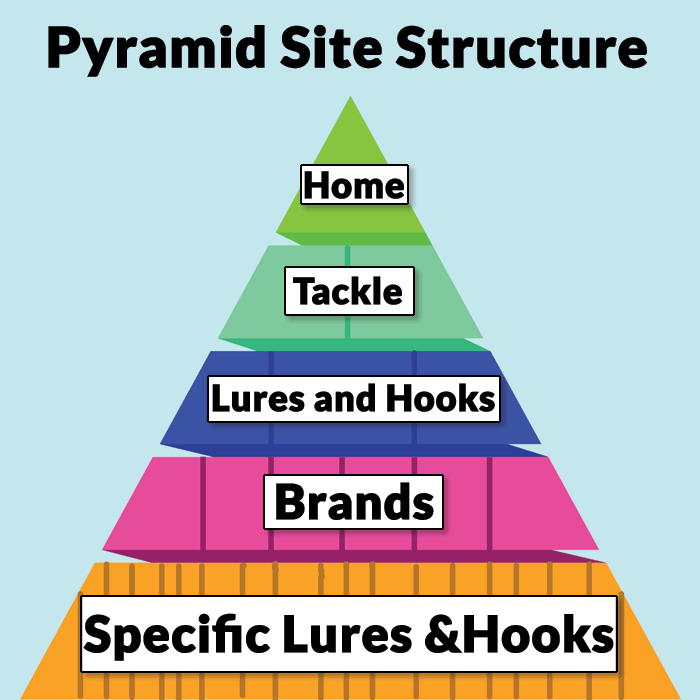Google’s John Mueller, in an SEO office-hours hangout, was asked about site navigation and the consequences of making big changes. Mueller recommended the pyramid site structure and discussed the pros and cons of making major changes to site navigation.
Mega Menu with Over 1,000 Links
The person asking the question has an ecommerce site with a static navigational menu that contains over one thousand links.
This is generally known as a flat site structure. It’s call flat because if you create a map of all the links, there is no hierarchy to the links since every web page is one click away. So the structure appears to be flat.
The flat site structure evolved in the early 2000’s as a way to maximize how much of a site is indexed by search engines and to ensure that every page receives an adequate amount of PageRank from links to the home page in order to boost rankings.
Back in the early days of SEO, many publishers engaged in reciprocal linking and directory submission strategies for links. The most common approach was to point most of the links to the home page so that PageRank could trickle down from the home page.
Linking to as many pages as possible from the home page, a flat site structure, was a way to maximize the ranking power of all the pages back in the early days of SEO.
Will a Drastic Change to Navigation Harm Rankings?
The major concern to the person asking the question is whether making this very dramatic change will negatively affect rankings.
This is the question asked:
“We have a site with a mega menu that has over 1,000 links.
It used to be that this mega menu, back in 2018, would only load upon user action.
So when a user hovered above the navbar AJAX probably loaded those links.
At some point in 2018, we added those static links and, I know correlation isn’t causation but around that same time we saw a big drop in our search traffic.
And now we are… contemplating removing these links from our navbar as static links and going back to links that only load upon user action with the AJAX call.
We are, nevertheless, maintaining a clear path to all of these links on relevant pages.
So we’ll still have a clear crawl path to those links but only on the relevant pages rather than having these links on every page.
So we’re wondering, what could possibly be the impact or ramifications of removing these 1,000 mega menu links or static links, even though we are still retaining a crawl path to all of these links on relevant pages?”
John Mueller began his answer by explaining that there are many nuances that go into giving a precise answer that is specific to the site in question.
It’s a way of explaining that what he’s about to say is a general response and not necessarily specific to the site in question.
Mueller responded:
“I think on the one hand, it’s kind of hard to say, because I don’t know how the rest of your site is structured.
So if for example these 1,000 pages are all of your pages, then it would be very different compared to say these 1,000 pages are your categories and you have a million… of subcategories or something like that.”
Mueller followed up by saying that in general, updating a site navigation from a flat structure to one that is more meaningful in terms of relevance and topics is a good approach… in general.
Here is what John Mueller said:
“But in general, what you’re looking at from a change point of view is going from a more of a flat site structure to a more… deeper site structure.
And that’s something where sometimes, that can definitely make sense.
So it’s something we sometimes see folks kind of obsessing about limiting the crawl depth, for example and trying to make it so that Googlebot can crawl to all pages in a very quick time.
And to some extent, I think that makes sense.”
Benefits of a Pyramid Site Structure
Mueller then goes on to explain the benefits of a pyramid site structure.
He says that it helps Google understand the context of different categories and pages.

A pyramid site structure has been around since the early 2000s. The concept is to create a site where the home page is focused on the most top level and general keyword and the deeper you go into a website the more specific the categories and pages become.
Origin of Theme Pyramid Site Structure
The reason why SEOs in the early 2000’s organized sites by theme is because there were several search engine research papers that centered on using the concept of themes for organizing the link graph and understanding web pages.
The search industry understood that if search engines were looking for themes in links and web pages, then it made sense to organize websites by the topic (or theme).
For example, a site about fishing supplies might have “Fishing Tackle” as the topic focus of the home page. The next click down could for example be to major category sections of the site like hooks, lures, and outdoor clothing.
The next clicks down from the major category topic sections are to gradually more specific products and brands.
Eventually, at the deepest level of a site, the bottom of the pyramid, there will be more of the longtail type of keywords that are hyper-specific as to a product, brand, model size, and color.
The bottom of the pyramid has many “bricks” which are analogous to web pages. The higher you go the less bricks there are as the pyramid tapers to a point that represents the home page and the main theme of the website itself.
One of the earliest discussions of the pyramid site structure was in a 2001 WebmasterWorld discussion of Theme Pyramids, which predates the similar Silo site structure idea by a few years.
The second post in that 2001 discussion is by a member named Oilman, who posted:
“I’ve always thought of themes as pyramids. You put your main general topic at the top and then support it with subtopics in the next level down. The support those subtopics with subtopics in the third level down etc.”
John Mueller on Pyramid Structure Approach
This is how Mueller explained it:
“On the other hand, kind of more the top down approach or pyramid structure helps us a lot more to understand the context of individual pages within the site.
So in particular, if we know this category is associated with these other subcategories then that’s a clear connection that we have between those parts.
And that definitely helps us to understand how these things are connected, how they work together a little bit better.
Whereas if it’s very flat, then we think, oh all of these are equally important and we don’t really know which of these are connected to each other.
So from my point of view, I think for a lot of sites it makes sense to have more of a pyramid structure.
But at the same time you don’t want it to be such that it’s like you have to click through a million times to actually get to the actual content.
You need to have…I don’t know… some reasonable number of clicks, essentially, to get to the content.”
The person asking the question responded by explaining that they’re an ecommerce site and that many SEO firms they spoke with advised against changing the navigation structure.
The SEO firms advised against changing the navigation structure because it would be bound to have a negative effect.
The person asking the question asked:
“I’m wondering if an empirical statement like that could be made?”
John Mueller answered:
“I don’t think it would always have a negative effect.
I do think if you make it too deep, then that makes it harder for us to crawl and harder for us to pass the signals around.
But it’s not the case that a super flat structure is going to be better than a kind of reasonable pyramid structure.
So personally, I would try to aim for more of a pyramid structure just to make it so that it’s easier for us to understand the context of the individual pages and to forward the signals into kind of related areas easier.
But it’s also something which… it’s a very significant change on a site like that.
So it’s something where I understand that it makes sense to kind of get more input on the options, maybe even to test things out, like you take one category and say I’ll try it here and see what happens with regards to crawling, with regards to indexing, with regard to rankings… all of these things because it is quite a big step when you change your site from kind of a super flat layout to more of a pyramid layout.”
Pyramid Site Structure
The pyramid site structure preceded other site structure schemes like the “silo” site structure.
The pyramid site structure is similar to the silo structure in that they both focus on creating a hierarchical order of topics. Organizing topics is also known as creating a taxonomy.
In a pyramid site structure one can organize web pages in whatever manner makes sense to the publisher.
In a silo structure, web pages are strictly organized by semantics, by keywords. Some may find that approach somewhat artificial but it’s a popular tactic nonetheless.
What I like about the pyramid site structure is that it’s so flexible that one can order things in any way that makes sense to a person.
And if it makes sense for users then it will generally make sense for search engines.
Citation
Watch the Google Office-hours Hangout
The relevant part begins at about the 56 minute mark.




